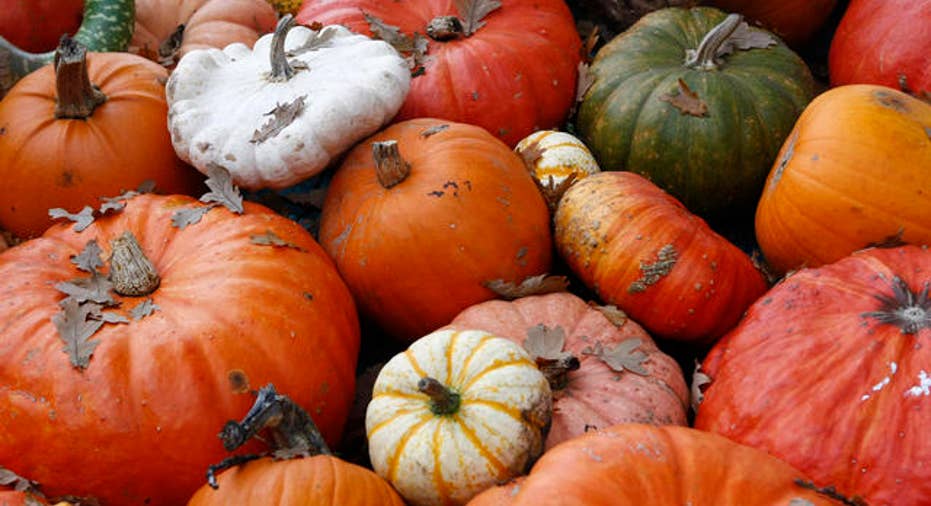Get Ready to Pay More for Your Pumpkins

As autumn sets in and Halloween approaches, families nationwide will be decorating their stoops and tables with farm-fresh fall items including pumpkins, Indian corn, winter squash and gourds of all sizes. But after months of bad weather in the Northeast, many farmers are cautioning that supplies will be short and prices will be high on the East Coast.
“We are seeing the cost of local pumpkins double from last year. On top of that, my crop is half what it normally is,” says Norm Schultz, farm manager at Linvilla Orchards in Media, Penn., the largest pick-your-own agritainment farm in the Northeast, which attracts an estimated 10,000 visitors per day.
By Sept. 20, Linvilla had already thrown away more than 10,000 pounds of rotten pumpkins–far more than the farm usually scraps by Oct. 31 in a typical year. But Linvilla is still doing well compared to some, according to Schultz, who says that countless other local farmers lost their entire pumpkin crop. The main problem in keeping crops viable has been what Chester, N.J., farm owner Kurt Alstede refers to as “unprecedented” rainfall.
“We’ve had almost three feet of rainfall through the mid-Atlantic in the last five weeks. The normal rainfall for the entire year is only about 42 inches, so this is just a disaster. Not only have we lost crops, we have also suffered a tremendous amount of customer loss,” says Alstede. “People want to see Norman Rockwell weather when they are picking pumpkins and apples, and we just haven’t been able to give it to them.”
At Alstede’s farm, the price per pound for pumpkins has jumped to 65 cents from 59 cents last year. Schultz set his prices in August and will have to absorb the excess costs this year, something that is not going to be easy.
Linvilla’s crop was so hurt that Schultz has already contacted suppliers in Indiana, Michigan, and Buffalo, N.Y., to order an additional 80,000 pounds of pumpkins. Of course, trucking in pumpkins presents another financial problem. Schultz says that diesel fuel is weighing in at $1 per gallon more expensive this October than the same time last year; per-load, the farm could be facing a $2,500 bill for transportation alone.
“On the flipside though, at least we will have pumpkins. Honestly, we are most curious about how big-box stores are going to manage. It will be interesting to see how quickly businesses can find a new supplier if the supplier they’ve been using for years doesn’t have a crop to sell,” says Schultz.
Ricky Volpe, a research economist at the USDA-Economic Research Service in Washington, D.C., says that it’s no surprise that pumpkins and other fall farm goods are seeing a substantial rise in price this year.
“In a historical sense, we saw a higher spike in 2011 than we have seen in a long time,” says Volpe. “Corn, soybeans, everything is costing a little more.”
Stewart Ramsey, a principal and senior economist at IHS says that for 2011, the increase in food prices stands at 3.7% at the time this article was published. This compares to a rate of 0.8% for all of 2010.
“In 2007 we had 4% growth, and that was considered extreme, so now we are moving back up in that territory,” says Ramsey. “If you were to write a recipe for the worst growing conditions for things like corn and pumpkins, you would say hot and dry in the summer and then wet in August and September, and that’s exactly what we’ve had. The pumpkin crop ripened up early and now you’ve turned the sprinklers on, and it’s a real challenge to keep them from rotting.”
Another challenge faced by large farms like Linvilla Orchards is the increase in hay prices. Hayrides are often a staple of larger farms’ agritainment offerings; wet weather led to rotting hay, which caused a sharp increase in the price of hay bales.
“The cost of hay has really gone up, because you can’t just make a bale of hay in one day. You have to cut it and then rake it and then leave it in the field to dry and cure,” says Rob Ferber, senior manager of Linvilla Orchards. “The rain will prevent the drying and curing, and then you’re left with no hay.”
Alstede says that although his farm will be raising the price of some fruits and vegetables this year, he expects that consumers will spend about the same amount of money on things like corn, pumpkins and squash this year compared to last year.
“They’re going to spend about the same amount, but they’re going to be buying a little less. The reality is that certain things are in short supply, so we hope it’s all going to work out.”
As for any tips for consumers, Alstede says that things like Indian corn may be difficult to find because with the wet weather, it’s been getting moldy and sprouting in the fields. If you see it at one farm, there’s no guarantee you may see it at another. Also, consumers should “manage expectations” when it comes to how long their pumpkins will last.
“In years past, perhaps a pumpkin would last through Christmas, but now you’ll be lucky if it lasts through Thanksgiving. They are not going to hold up as well as they usually do, due to absorption of excess water and the mold spores they’ve been exposed to,” says Alstede.
But the most important things consumers should do this fall is to go out and support their local farmers, Alstede says.
“Local farmers need consumer support now more than ever. This will be the most difficult economic year my generation of farmers has ever faced.”